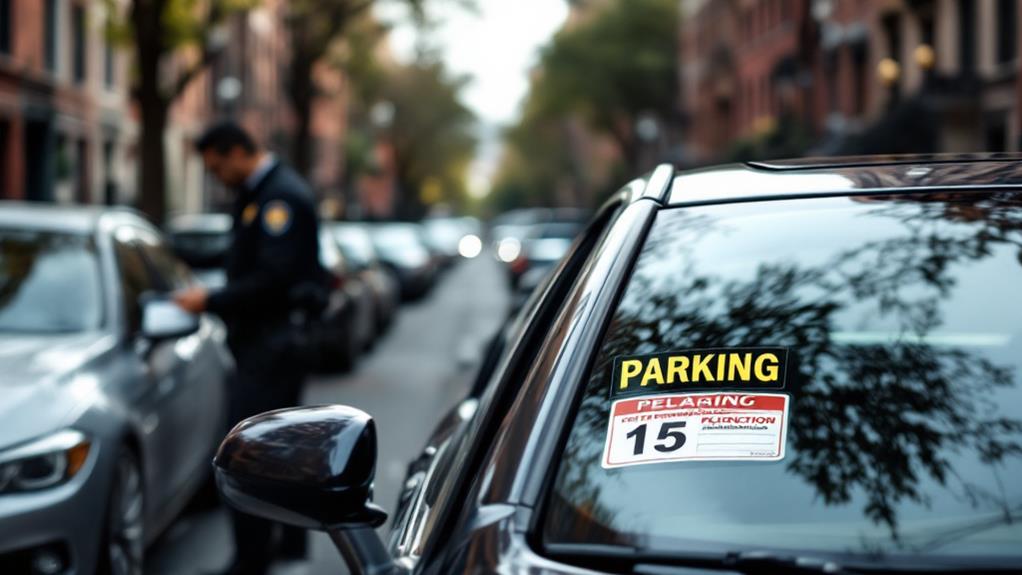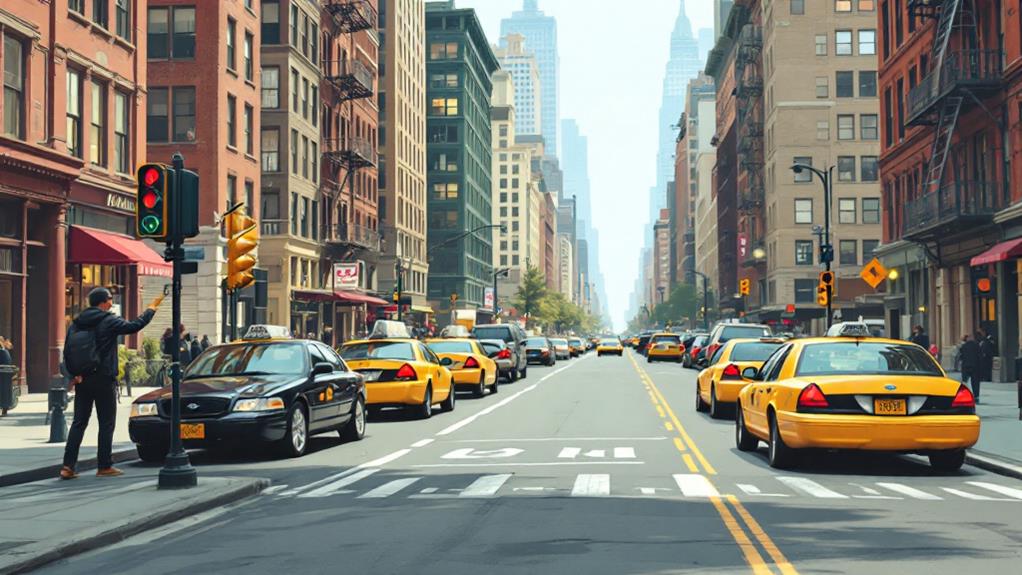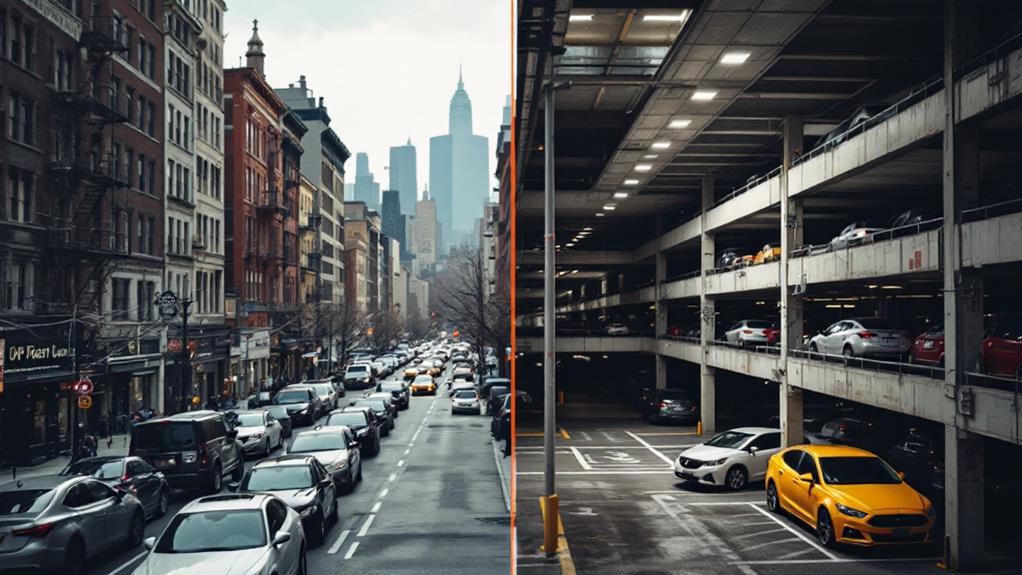The Impact of NYC's Congestion Pricing on Parking Availability
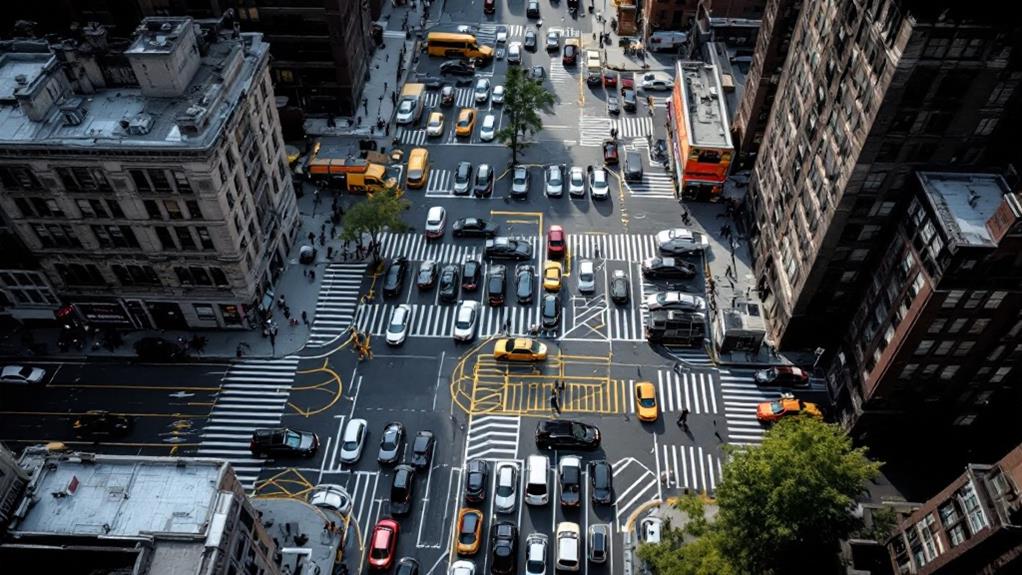
NYC's congestion pricing plan will greatly affect parking availability beyond Manhattan's central business district. You'll see increased parking pressure in areas just outside the congestion zone, particularly north of 60th Street. Commuters trying to avoid the fee may park their vehicles and switch to public transit, creating new challenges for uptown neighborhoods. This shift could lead to overcrowded streets and frustrated locals in areas like Upper Manhattan and the Upper West Side. The city is considering strategies like expanding park-and-ride facilities, improving public transit, and implementing residential parking permits to address these issues. Understanding the full scope of these changes will help you traverse the changing urban topography.
Understanding NYC's Congestion Pricing Plan
With the aim of reducing traffic and improving air quality, New York City is set to implement an innovative congestion pricing plan. Starting January 2021, you'll encounter a new fee when driving into Manhattan's central business district south of 60th Street. This congestion pricing program, passed by the New York State legislature in 2019, aims to tackle traffic congestion, fund transit improvements, and reduce emissions.
You'll find that the Metropolitan Transportation Authority's Triborough Bridge and Tunnel Authority is overseeing the system's implementation. They'll use variable pricing based on factors like time of day and vehicle size. If you're bypassing the zone on the FDR Drive or West Side Highway, you won't be charged.
This plan will likely impact your parking habits. You may find increased competition for parking spots north of 60th Street as drivers try to avoid the fee. Consider exploring alternative transit options or checking if you're eligible for parking permits. The New York City Mayor and officials hope this program will encourage more use of public transportation, ultimately easing congestion in the lively heart of the city.
Anticipated Changes in Parking Demand
As the congestion pricing plan rolls out, you're likely to see significant shifts in parking demand across Manhattan. The MTA anticipates increased parking pressure in areas just outside the congestion zone, particularly north of 60th Street. You'll find commuters seeking to avoid the toll by parking their vehicles and switching to public transit for the final leg of their expedition.
This shift in behavior is expected to create new challenges for residents and businesses in uptown neighborhoods. You'll notice increased competition for parking spaces, potentially leading to overcrowded streets and frustrated locals. The MTA acknowledges these potential issues and recommends an 18-month study to assess the impact on parking availability outside the central business district.
Communities with good public transit access may become hotspots for out-of-town drivers looking to park and dodge the congestion pricing toll. As a result, you might see these areas transform into "ground zero" for parking demand. The MTA's analysis highlights the need for careful monitoring and potential adjustments to address these changing parking dynamics. As congestion pricing reshapes Manhattan's traffic patterns, you'll witness a ripple effect on parking demand throughout the borough.
Impacts on Different City Neighborhoods
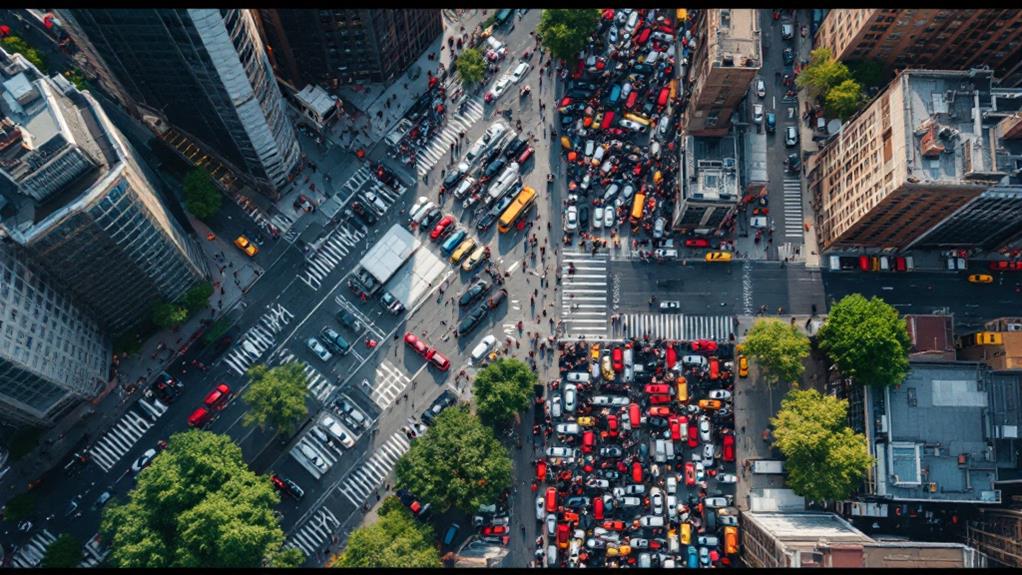
The impact of congestion pricing on different New York City neighborhoods will vary considerably depending on their location and transit accessibility. You'll likely see the most significant changes in areas just outside the Manhattan Central Business District, particularly in Upper Manhattan and the Upper West Side.
As drivers seek to avoid the toll implemented by the Metropolitan Transportation Authority, these neighborhoods may become "ground zero" for out-of-town commuters looking for free or low-cost parking. This shift could exacerbate existing parking issues, with residents finding it even more challenging to secure spots near their homes.
The New York State Legislature and Department of Transportation are under pressure to address these concerns. One potential solution is implementing residential parking permit programs, which 53% of New Yorkers supported in a 2013 survey. However, creating an effective system presents challenges, as seen in other cities.
The Triborough Bridge and Tunnel Authority's congestion pricing plan aims to reduce traffic, but it may inadvertently increase parking demand in areas with good transit access. As New York Public Radio has reported, residents want parking solutions to mitigate these anticipated impacts on their neighborhoods.
Public Transportation and Alternative Modes
Anticipating a surge in public transit ridership, New York City's congestion pricing plan is set to reshape how people move throughout the city. You'll likely see more commuters opting for mass transit options to avoid the congestion charge. The MTA is gearing up for this shift by planning to invest congestion pricing revenue into improving subway and bus services, as well as commuter rail networks.
As public transportation becomes more reliable and accessible, you might find yourself considering alternative modes of travel. Walking, biking, and e-bikes could become more attractive options for your daily commute. The city is also working on enhancing first-mile/last-mile connectivity, which means you'll have easier access to bike-sharing and other micromobility options to complement your subway or bus ride.
To make your multimodal voyage seamless, the city, MTA, and transportation providers are collaborating closely. This coordination aims to facilitate that you can effortlessly switch between different modes of transport, making your commute smoother and more efficient. As these improvements take shape, you'll likely find that relying on public transportation and alternative modes becomes increasingly convenient and appealing.
Residential Parking Permit Proposals
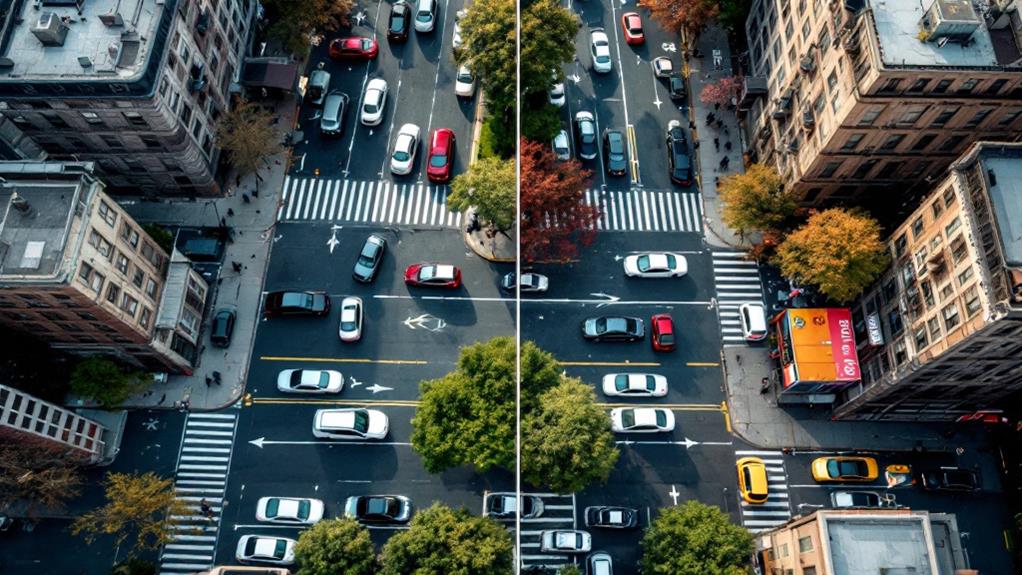
Many Upper West Side residents are advocating for residential parking permits as a potential solution to the anticipated parking crunch caused by congestion pricing. They're proposing permit fees ranging from $10 to $90 per month, hoping to address the expected increase in parking demand. However, their efforts to persuade politicians have been unsuccessful so far.
Implementing a residential parking permit program in NYC isn't straightforward. The city currently lacks the authority to do so, and state legislation would likely be required. Additionally, a 2019 report highlights challenges faced by other cities with similar programs, including the potential to induce even greater parking demand.
There are concerns that a poorly designed permit system could create unintended consequences. Areas with good transit access might become "ground zero" for out-of-town parking, exacerbating the problem rather than solving it. As NYC grapples with the impending changes brought by congestion pricing, finding a balance between resident needs and overall transportation objectives remains essential. The debate over residential parking permits continues to be a contentious issue in the broader discussion of NYC's evolving transportation environment.
Economic Implications for Local Businesses
While residential parking permits remain a contentious issue, local businesses are bracing for the economic impact of NYC's congestion pricing. New York's plan to implement congestion pricing in Manhattan has raised concerns about its effect on neighborhood-level commerce, particularly for businesses located just outside the congestion zone.
You'll find that reduced parking availability could make it harder for customers to access local shops and restaurants. Some studies suggest that overall economic activity in areas surrounding the congestion zone might decrease by up to 10%. This potential loss of business is a significant worry for small enterprises already operating on tight margins.
To address these challenges, you'll need to contemplate various strategies. Expanding metered parking, introducing residential parking permits, or partnering with private garages could help mitigate the impact. However, the key to success lies in effective communication and collaboration between local businesses, residents, and policymakers.
As New York moves forward with congestion pricing, it's essential to balance the benefits of reduced traffic with the economic needs of local businesses. By working together, you can develop solutions that maintain customer access and support neighborhood-level commercial activity.
Strategies for Mitigating Parking Challenges
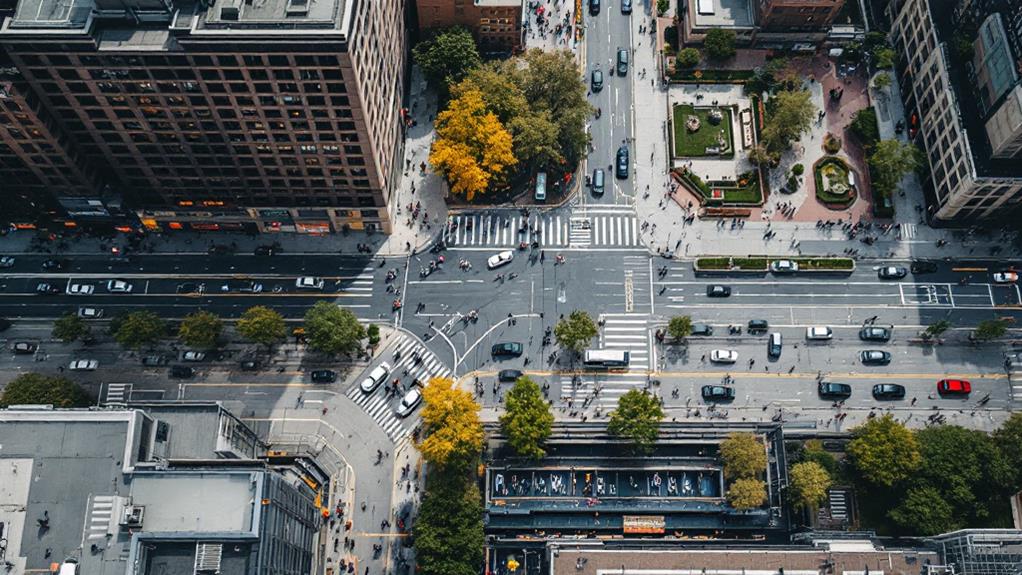
New York City's implementation of congestion pricing calls for innovative strategies to mitigate parking challenges. You'll find that residential parking permit programs can help manage increased demand for on-street parking in neighborhoods adjacent to the congestion zone. However, these programs must be carefully designed to avoid unintended consequences.
To address the changing parking needs, consider these key strategies:
- Expand park-and-ride facilities and shuttle services
- Improve public transit connectivity and service frequency
- Implement residential parking permit programs
- Monitor and adjust parking policies and pricing
By expanding park-and-ride options, you're providing commuters with alternatives to driving and parking within the congestion zone, reducing pressure on local parking supplies. Improving public transit service encourages mode shift away from private vehicle use, further alleviating parking demand.
As you navigate these changes, remember that ongoing monitoring and adjustments to parking policies are paramount. You'll need to address shifting patterns and evolving needs in the wake of congestion pricing implementation. By focusing on these strategies, you can help facilitate a smoother transition and better manage parking challenges in affected areas.

